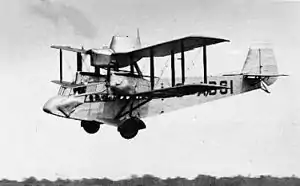Airspeed Ferry
The Airspeed AS.4 Ferry was a 1930s British three-engined ten-seat biplane airliner built by Airspeed Limited at York.
| AS.4 Ferry | |
|---|---|
 | |
| G-ABSI, the first Airspeed Ferry, in flight. | |
| Role | 10-Passenger Airliner |
| Manufacturer | Airspeed Limited |
| Designer | N.S. Norway/A. H. Tiltman |
| First flight | 1932 |
| Introduction | 1932 |
| Retired | Late 1941 |
| Number built | 4 |
Design and development
Designed to meet a requirement for a pleasure flying airliner from Sir Alan Cobham (an Airspeed director), the Ferry was an unusual configuration biplane with a third engine mounted in the upper wing (it was usual to mount a third engine in the nose). The engine arrangement was designed to give the pilot a better view. Not all three engines were the same, the lower engines were de Havilland Gipsy IIs, and the upper wing had an inverted de Havilland Gipsy III. The lower wing was mounted at the top of the fuselage to give passengers an unobstructed view of the ground.[1]
Operational history
The first aircraft G-ABSI Youth of Britain II first flew on 10 April 1932 from Sherburn-in-Elmet Airfield, followed soon after by the second aircraft G-ABSJ Youth of Britain III. In the first season of operating, the two aircraft carried 92,000 passengers.[2]
The outbreak of World War II caused the first aircraft (G-ABSI) to be pressed into service with the Royal Air Force in 1940, as AV968, and used at Halton until November 1940. It later became an instructional airframe registered as 2758M.[3]
The second aircraft was sold in India to Himalaya Air Transport and Survey Company Limited in 1934 as VT-AFO. It was used to ferry pilgrims from Hardwar to Gaucher, and was destroyed by vandals in a hangar fire in 1936.
The third (G-ACBT) and fourth (G-ACFB) aircraft were built for the Midland and Scottish Air Ferries Ltd and used on services from Renfrew to Campbeltown, Belfast and Speke. The firm closed in 1934 and the aircraft were put up for sale. G-ACBT was not sold and was dismantled in 1941. G-ACFB returned to England to be used for pleasure flying for Air Publicity Ltd. It was pressed into service with the Royal Air Force in 1941 and later became an instructional airframe.
Operators
Civil operators
- Himalaya Air Transport and Survey Company Ltd
- Air Publicity Ltd
- Midland & Scottish Air Ferries Ltd
- National Aviation Day Displays Ltd
- C.W.A. Scott's Flying Displays Ltd
- Portsea, Southsea and Isle of Wight Aviation Ltd
- Sir Alan Cobham
- C.W.A. Scott
Specifications
Data from British Civil Aircraft since 1919:Volume I[4]
General characteristics
- Crew: 1
- Capacity: 10 passengers[5]
- Length: 39 ft 8 in (12.09 m)
- Wingspan: 55 ft 0 in (16.76 m)
- Height: 14 ft 3 in (4.34 m)
- Wing area: 610.5 sq ft (56.72 m2)
- Empty weight: 3,300 lb (1,497 kg)
- Max takeoff weight: 5,400 lb (2,449 kg)
- Powerplant: 3 × de Havilland Gipsy II and III air-cooled inline piston, 120 hp (89 kW) each
Performance
- Maximum speed: 112 mph (180 km/h, 97 kn)
- Cruise speed: 100 mph (160 km/h, 87 kn)
- Stall speed: 49 mph (79 km/h, 43 kn) [6]
- Range: 340 mi (550 km, 300 nmi)
- Service ceiling: 15,500 ft (4,700 m)
- Rate of climb: 800 ft/min (4.1 m/s)
References
- Notes
- Cobham, Sir Alan (1978). A Time to Fly. London, UK: Shepheard-Walwyn (Publishers). p. 155. ISBN 0 85683 037 2.
- "The Work of the Airspeed Ferry". Flight, 17 November 1932, p. 1088.
- Jackson 1974, pp. 14–15
- Jackson 1974, p. 15
- Jackson 1974, p. 13
- Flight 15 April 1932, p. 317
- Bibliography
- The Illustrated Encyclopedia of Aircraft (Part Work 1982–1985). Orbis Publishing.
- "The Airspeed "Ferry"". Flight. No. 15 April 1932. pp. 317–320.
- Jackson, A.J. (1974). British Civil Aircraft since 1919: Volume I. London: Putnam. ISBN 0-370-10014-X.
External links
| Wikimedia Commons has media related to Airspeed Ferry. |
- Airspeed Ferry – British Aircraft of World War II
